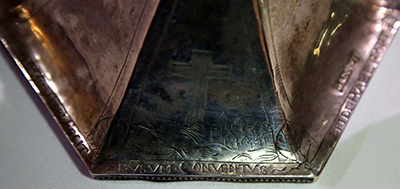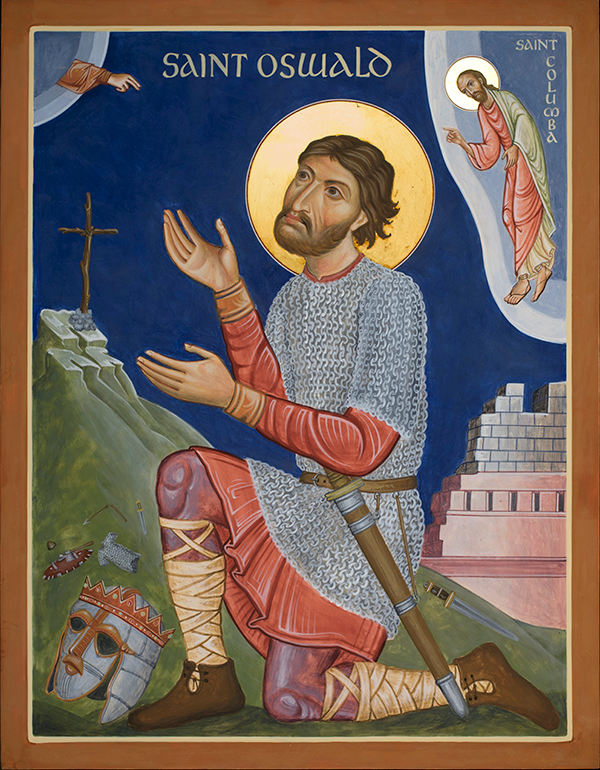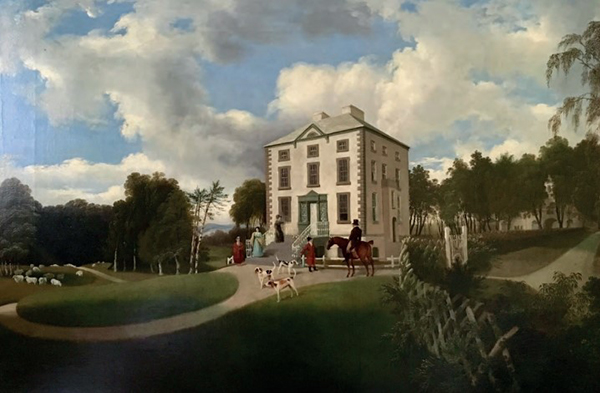The Templars and the mysterious Holy Rood of Ballinrobe
Published in Features, Issue 3 (May/June 2021), Volume 29By Michael Brabazon
In 1974, a young man by the name of Mike Brennan was exploring a dilapidated, derelict house in Swinford, Co. Mayo. He made his way up the Georgian mansion’s rickety staircase to the first floor, where he discovered a small, hidden cupboard set into the wall. Prising it open, he found a locked lead box, inside of which rattled a smaller object. He dutifully took the unopened box to the Sisters of Mercy in Swinford town; it was never seen again. But what was inside?
The mansion was my ancestral home, Brabazon House, and the object in the box may have been the missing founding relic of County Mayo—the culmination of a story of an English saint, the Knights Templar, O’Connor kings and the Mac William Bourkes.
The Templars of Temple House, Co. Sligo
Treated as an outlier of Irish Templar communities is the ruin of their castle at Temple House close to Ballysadare, a natural harbour on the Sligo coast. Local tradition says that it was founded in 1181, when the area fell within the Connacht kingdom of Rory O’Connor, the last high king. Coincidentally, in the same year Hugh de Lacy, de facto viceroy, married a daughter of King Rory, a political union that enhanced Rory’s standing as an equal with the Anglo-Normans and helped secure the latter’s western flank.
Hugh’s father, Gilbert de Lacy, signed over his estates in England and France to his sons in 1158 and became a leading Templar in England and Europe. After his brother’s death, Hugh inherited the estates, later adding those he gained in Ireland from 1172. Hugh’s power grew to the point of his being referred to in the annals as ‘king of Ireland’ and gave rise to rumours that he had commissioned a crown to be made. There was a coming together of interests between Rory and Hugh, but why Templars and why Temple House? There was a silver-lead mine at Ballysadare and the Templars’ sister order, the Cistercians, who mined their own roofing lead, established a community there in the 1150s. The Templars had cornered the European silver market and had a fleet to transport their goods between Ireland, England and their home port of La Rochelle, western France. Overlapping interests indeed.
At their suppression, the fate of the Templars in Ireland was about as mild as it could possibly be. A handful of leading Templars were rounded up in 1309 and put on trial in St Patrick’s Cathedral in 1310 but released within six months, as none of the charges were deemed credible. Pensions were still paid and Templars were permitted to join other orders. By papal decree, Templar property was handed over to the Knights Hospitaller, but the overlord of Temple House, Richard oge de Burgh, the Red Earl of Ulster, great-grandson of Hugh de Lacy, refused to cooperate. Intriguingly, the earl gave the estate to the order of the Fratres Cruciferi, often confused with the Order of Hermits of St Augustine (the Austin Friars) and the Knights Hospitaller.
Fratres Cruciferi
The origin of the Fratres Cruciferi lies in the Hospital of St John the Baptist in Jerusalem in 1099 (when the Crusaders arrived), the same root as the Knights Hospitaller. The order’s own myth-history went back to St Cyriacus, who aided St Helena in the discovery of the True Cross (on which Christ was crucified) in AD 327 in Jerusalem. The Fratres’ devotion was to the True Cross and St John the Baptist. The order’s first hospital-priory in Ireland is stated to have been founded before 1176 at New Gate, Dublin, but in fact there is an older Irish origin in Tuam, Co. Galway. King Turlough O’Connor, Rory’s father, had the Priory of St John the Baptist built for the Fratres in c. 1140, or possibly earlier, as part of a plan to establish Tuam as a centre of pilgrimage based on the relic (a minuscule fragment) of the True Cross obtained by Turlough in 1123 from an unrecorded foreign source. The relic was duly encased in what became known as the Cross of Cong and was relocated to Cong Abbey by King Rory, probably in the 1180s.
In Ballinrobe, south Mayo, there was a religious house of St John the Baptist which was linked to Ballinrobe Abbey. It belonged to the Knights Hospitaller, according to Knox’s History of the County of Mayo (1908), in which Knox states that they were there from some time before 1304 under a bailiff. This is problematic. In the Knights Hospitaller, the rank of bailiff was a high position in a headquarters community, and in the record of ecclesiastical tithes for 1302/07 there is no mention of such a place as St John’s, Ballinrobe. The term ‘bailiff’ was used by the Templars, however, for any of their office-holders and, being exempted from church tithes, the order’s own properties do not appear in the tithe register.
The site of St John’s, on the periphery and separated by marshy land, is exactly what we would expect of a hospital location (owing to the fear of transmissible diseases). So we have a religious house using the Fratres Cruciferi’s universal dedication to St John the Baptist and located in the right place for a pilgrim hospital but apparently a Templar establishment. There does appear to have been a dual occupancy between Templars and Fratres.
As to a date and reason for St John’s foundation, we can make a connection between the house and St Mary’s church on the south side of the Robe River. The latter was referred to as ‘Rouane’s church’ and St John’s as ‘Murone’, which I believe is a shortened ‘Mur-rone’, ‘house of Rouane’. The O’Duffy ecclesiastical sept of the O’Connor clan had engineered Tuam as a new archdiocese and created the diocese of Mayo. Felix O’Rouane, archbishop of Tuam (1202–35), an O’Connor relative, is the obvious candidate for the Rouane church of Ballinrobe. Overlapping with his reign, Céle O’Duffy was bishop of Mayo (c. 1184–1210), and O’Rouane’s predecessor as archbishop was Cadla O’Duffy. There was obviously an ongoing development of Ballinrobe as a pilgrimage centre.
Within the O’Connor kingdom there was also another Fratres Cruciferi priory-hospital at Rindown, Lough Ree. It was established, according to English claims, in 1216 by Philip de Angelo, but in 1216 Rindown was totally under O’Connor control and it would seem more likely that the Fratres’ priory pre-existed the English and was connected to St John’s at Tuam. When the Red Earl handed over the Templar estate to the Fratres Cruciferi, it may have been, in name, to the community at Rindown. In any event, Rindown was out of de Burgh control and in the midst of heavy to-and-fro warfare, whereas the Fratres at Ballinrobe and Tuam were safely within de Burgh territory.
The crowning glory of the ongoing development of Ballinrobe was the construction of the Augustinian abbey, founded by Roger Taaffe, some time before 1337. The abbey was the work of the de Burghs so it would seem that Taaffe was the first abbot. The Taaffes were a powerful Louth family and major patrons of the Templars in Ireland. This Augustinian order was that of the Austin Friars and the abbey was their first religious house west of the Shannon, effectively independent and from the outset connected to St John’s. As to the actual name of the abbey, in a 1940s survey it is referred to as the ‘Priory of the Holy Rood’, a term that is used for the True Cross in England but is unusual, to say the least, in Ireland, where Holy Cross and True Cross are the synonymous terms used.

Above: The base of a silver chalice made in Spain in 1663 for Ballinrobe Abbey, depicting the Holy Rood (True Cross) towering over Ballinrobe. (Fr Stephen Farragher)
A silver chalice discovered in 1922 a few miles south of Ballinrobe, made in Spain in 1663 for the abbey, bears an image of ‘the Holy Rood’ (the True Cross) towering over Ballinrobe. The indications, then, are that the de Burghs constructed the abbey to house a relic of the Holy Rood/True Cross. This provides the clue as to what drew pilgrims to pre-Ballinrobe and later the town, and of what the Templars-cum-Fratres were guardians.
The Holy Rood of Ballinrobe, Co. Mayo
In Petty’s map of 1685, the now-ruined church of Carrownalecka (or Carnalecka) at Ballinrobe is marked as ‘Holy Rood’. As above, the general usage of the name Holy Rood in England, coming from the Anglo-Saxon halig rōd, is synonymous with Holy Cross or True Cross. One would struggle, however, to find the name in Ireland even in latter times, and certainly none in Gaelic history, so we have an Anglo-Saxon-named church in the midst of pre-Norman Ireland. The church was rebuilt after 1170, most likely by Rory O’Connor, and called Temple Mór.
The lands of Mayo Abbey stretched to Holy Rood church, the monastic settlement known as Mayo-of-the-Saxons even into the Norman period owing to its foundation by St Colman, who settled his English monks there. Colman had been the bishop of Lindisfarne until 664, when the Synod of Whitby decided in favour of certain English traditions over those of the Irish church. Colman and a group of Irish and English monks left for Iona (headquarters of the Columban mission to Scotland and Northumbria) and thence for Inishboffin, off the Galway coast, taking with them some of the monastic treasures of Lindisfarne. Mayo was the final destination of the English monks c. 670, their leader being St Gerald, said to be a Northumbrian prince and accompanied by three brothers and a sister, Segretia (Segrid). Gerald’s own party arrived directly on the mainland, which means that there were two groups of Saxon monks who became united into one community.
Before settling at Mayo, Gerald and his followers were at a place called ‘Elitheria’, ‘land of the pilgrims’. If it was already a place of pilgrimage then the Ballinrobe area would fit the bill, as it was a Patrician location with numerous holy wells and churches. On the north side of the Robe, the hill overlooking the mouth of the river is Knock-na-heltie. The ‘eltie’ may be Irish for pilgrim, as in Elitheria, although this is disputed. Knock-na-heltie is also known as Knock-na-gulshy, ‘hill of the English woman’ (gaillsheach), which could be taken to refer to Segretia, for whom St Gerald founded a monastery.
One of the monastic treasures that St Colman brought from Lindisfarne was a relic of the True Cross, the halig rōd, the Holy Rood. There are no mentions of the relic at Mayo but in plain historical sight is the Holy Rood church. At the mouth of the Robe at Lough Mask there are two islands, one now part of the mainland owing to silting—Inishturra (‘pilgrimage [turas] island’) and Inishrobe, on which there was a church founded by monks of St Colmcille of Iona. The name of Ballinrobe, the town dating from the early 1300s, was taken from that of the Robe and the earliest written record (1307) calls it ‘Rodbad/t’, which can be translated as ‘harbour of the rod [pronounced ‘road’]’.

Icon of St Oswald, king of Northumbria, praying before the cross that he erected prior to his victory at the Battle of Heavenfield (633/4) and after a prophetic dream in which he was directed by St Colmcille (Columba), depicted here above him. He was later killed at the Battle of Maserfield, Oswestry (641/2), and his severed head impaled on a stake. Fragments of both cross and stake (‘holy stake’/halig rōd) subsequently became venerated relics. (Aidan Hart)
The cult of St Oswald of Northumbria
Neither the cult of the True Cross nor pieces of it existed in Northumbria or Iona in 664. What did exist was the cult of St Oswald, the martyred Christian king of Northumbria, and fragments of both the cross that he erected before his victorious Battle of Heavenfield (633/4) and the halig rōd (the original meaning being ‘holy stake’) on which his severed head was impaled after the defeat at the Battle of Maserfield, Oswestry (641/2). By the time of Colman’s departure from Lindisfarne, Oswald and his relics were widely venerated and were considered efficacious for any number of illnesses, including the plague. He was later the patron of crusaders, being regarded as a martyred soldier of Christ. The Holy Rood of Ballinrobe is, I contend, Oswald’s halig rōd, which became conflated with the True Cross of Christ.
In 1338 Edmund de Burgh, the inheritor of the family titles and estates, came to ‘visit the friars of Ballinrobe’, a trip that was to be his last. He was captured and drowned in Lough Mask by the Staunton bodyguards of his cousin, Edmund Albanach Bourke. The latter escaped any English attempt to arrest him, returning two years later to declare himself the first Mac William chieftain. The inaugural ceremony’s obvious location would have been the abbey with its holy, royal, relic.

Above: Brabazon House, Swinford, in 1797. Built twenty years before, it had fallen into disrepair by 1974, when explored by the young Mike Brennan, finally being demolished in 1981. (Robin Wells)
Now you see it, now you don’t
During the Cromwellian war, I believe that the abbey’s treasures were taken into safekeeping by local families (principally the Nolans, seated at Ballinrobe Castle) and later regarded as family possessions. The Nolans, related to a network of local landowning families, including mine, were dispossessed and relocated to Ballinderry Castle, close to Tuam.
In 1642 a silver chalice was given to Ballinrobe Abbey by the archbishop of Tuam, Malachy O’Queely. This chalice was gifted to Stonyhurst Catholic College in Lancashire in 1919 by one of the Bodkin family, cousins of the Nolans. Around the same time, the British Museum acquired the seal of Ballinrobe Abbey.
My ancestor, Captain William Brabazon of Lough Mask Castle and later Kilconduff (Swinford), had his name changed from Bourke to Brabazon as a child in the mid-1650s when he inherited the Brabazon estates. He was the senior descendant of the last legally recognised Mac William, Sir Richard Bourke of Deel Castle, who formally agreed the Composition of Mayo in 1585.
In 1730 my family relocated to what became Swinford and in 1777 had a Georgian house built in Brabazon Park. It had fallen into disrepair by 1974, when it was explored by the young Mike Brennan, finally being demolished in 1981. The whereabouts of the missing relic, the Holy Rood of Ballinrobe, remains a mystery.
Michael Brabazon is a Mayo historian.
FURTHER READING
S. MacKenzie, ‘Saint Oswald, Christ and the Dream of the Rood: mutable signs at a cultural crossroad’ (unpublished Ph.D dissertation, University of Tennessee-Knoxville, 2010).
G. Murray, The Cross of Cong (Newbridge, 2014).
V. Orschel, ‘Maigh Eo na Sacson: Anglo-Saxons in Early Christian Mayo’, History Ireland 9 (2) (2001).
















